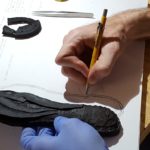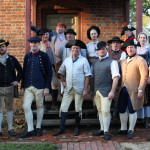The oldest surviving shoes date to 10,000 B.C. They were made of braided sagebrush bark and were discovered in Oregon. This is the sort of information D.A. “Al” Saguto lives and breathes.
Not only is Saguto Colonial Williamsburg’s master boot and shoemaker – or cordwainer. He’s also a leading U.S. authority on historical shoemaking and the archaeology of shoes. He lectures on the subject all over the world, as well as serving as an instructor, consultant and author on all things shoe-related.
“The shoe,” he says, “is the only garment that we wear that takes on a permanent impression of the wearer.”
Since shoes hold many clues about the person who wore them, they are fascinating objects to study from an archaeological perspective, he explains.
Saguto has for more than a decade served on behalf of the Colonial Williamsburg Foundation as a consulting curator to Historic Jamestowne, where archaeologists have unearthed a large number of shoes from the site of the first permanent English settlement in the country.
He calls this “rescue archaeology” because shoes are very perishable, and his goal is to extract as much information as possible before the shoes degrade.
“You can tell the general health of the wearer from the imprint of the shoe the way you can with no other garment,” he says.
In October, Saguto hopes to represent United States at the International Congress on Shoes in History, held this year in the Czech Republic. There, he’ll present a paper on the Historic Jamestowne shoes.
Besides his work at Historic Jamestowne, Saguto is occasionally called on to consult or to make shoes for other museums. A George Washington exhibit at the Smithsonian’s Museum of American History in Washington, D.C., includes his work.
Making Them the 18th-Century Way
At Colonial Williamsburg, all the shoes and boots are made by hand in the 18th century way in the Shoemaker’s Shop on Duke of Gloucester Street.
In fact, the system of delineation of labor in their shoemaking process goes back to about 270 B.C. One person cuts the pattern out of the leather, one sews the uppers and someone else does the finishing work, for example.
Saguto manages the shop, which has three journeymen, Tim Wilson, Val Povinelli and Brett Walker. Like them, Saguto takes his turn explaining the work to shop visitors while making handmade shoes and boots. Each man works in 90-minute intervals, speaking with the public while also making shoes.
“It’s a bit like trying to perform neurosurgery in a fishbowl,” he jokes.
At the root of many visitors’ question is the “relevance” of the work they do, Saguto says. Since shoes are objects that we still use today, they readily identify with what’s being produced in the shop. Everyone wears shoes, even if they are not familiar with the process.
“We’re experimental archaeologists. What we do does not make a statement all on its own, but contributes to a body of knowledge about the garment and historical technology.”
Visitors can learn how shoes were made in the 1700s, see the environment they would have been made in and learn about the large demand for various types of shoes by the colonists.
In addition, they also get a feel for the type of person who would have been a shoemaker, what his life would have been like, how he would have been viewed in the community and how his trade would have been valued.
‘The Gentle Craft’
While it may not be economically feasible to mass-produce shoes this way now, there is still value in preserving the shoemaking method, which was called “The Gentle Craft” because it’s not as dirty or grimy as some of the other trades.
“What’s the advantage to forgetting how to make a shoe, sew a garment, build a house or how to grow your own food?” Saguto asks.
In colonial times and even a quarter-century ago, the trades were more valued and respected, he says.
“There’s a huge chasm over the past 25-30 years that makes it harder for people to relate to us,” Saguto says, because of the distance now between the producers of objects like shoes and the consumers who use them. “It used to be perfectly normal to do artisanal things for a living. Today, it’s rarer and people look at it curiously.” He says many even view these trades as “obsolete.”
Saguto grew up in a family of watchmakers and jewelers at a time when he says the trades were more highly revered. Then, many people could identify with what you did simply because there was often someone in their own family who did the same thing or something similar. That’s no longer the case.
It’s also much harder now to make a living as a tradesman or artisan.
“I grew up next to an artisan’s workbench,” says Saguto, whose father ran D’Alberts Chevy Chase Jewelers from 1941-1979. This was a premiere jewelry and watchmaking business in Washington, D.C. at the time, he says, and his father was the horologist – or watchmaker — to President Gerald Ford.
Jewelers and watchmakers actually go back in his family five or six generations. However, Saguto points out, there were also “shoemakers in the family woodpile,” the first in 1750s Maryland. A great uncle made both men’s and women’s shoes in Paris. He also made shoes for the Queen of Belgium and won a gold medal in 1913.
Even though Saguto did learn a few tricks of his father’s trade while growing up, like his great uncle, he was more interested in shoes and shoemaking.



Wyatt says
Hello, I was wondering what styles of shoes might be worn by an 18th century blacksmith, and where I might find patterns to make those shoes. I have an ancestor that happened to be a blacksmith and also fight as part of a French militia at the Battle of Fort San Carlos (otherwise known as the Battle of St. Louis). I want to be as historically accurate as I can when adopting this persona at each event I attend.
Is there evidence of men’s lace up “half boots”, sometimes known as “Hi Lo”s, or “Jefferson Bootees” prior to 1800?
Thanks much.
Hi Stephen, thanks for your question.
Half boots, sometimes referred to as shoe-boots in the period, are certainly in evidence throughout the 18th century. They evolved from 17th century workman’s boots known as buskins. By the time of the American Revolution, half-boots had become popular with sport hunters and jockeys and artwork frequently shows these individuals wearing them. We know that they also continued to be worn by laborers, farmers, tradesmen, and occasionally even slaves. However, it does not appear that they were as common as shoes for everyday use. Certainly they would have cost more, even a coarse farmer’s half boot required more material and fitting, and would not have been as versatile as a good pair of shoes. Surviving examples are rare (we know of two that date from the 3rd quarter of the 18th century) and, ultimately, we feel they were more common than riding boots but not as common as shoes.
“Jefferson Bootees” are distinct style that appear in the 19th century and are lower cut than the 18th century half-boot.
Visitors to the shop have the opportunity to see reproductions our staff have made of the above mentioned examples. One is very much a farmer’s boot while the other is far more refined and features construction techniques typically seen on riding boots.
Regards,
The Shoemakers